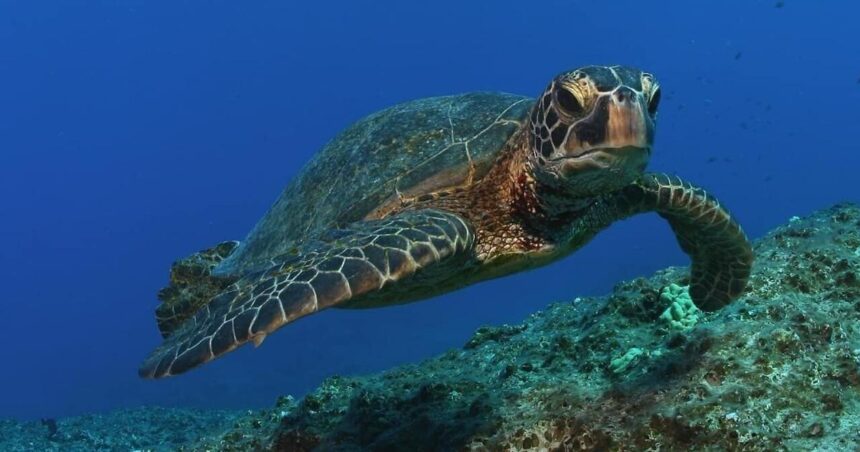St. George Island may nestle along Florida’s Forgotten Coast, but it has stolen the spotlight for a second consecutive summer.
Dr. Stephen Leatherman, more commonly known as Dr. Beach, named St. George Island State Park America’s top beach for 2023.
But the island is retaking center stage this year for an entirely different reason.
Missing Inhabitant Returns After Ten Years
Tourists are not the only ones attracted to the region’s pristine beaches. While sea turtles regularly nest on St. George Island, something special happens this year.
Kimberly Crossen, Assistant Coordinator of the St. George Island Turtle Patrol, provides insight into the region, its adored inhabitants, and the community efforts to protect them.
Affectionately called “Turtle Lady” by locals, Crossen says, “We host three species of sea turtles: the loggerhead, the green turtle, and the leatherback. The loggerhead is the most common, averaging about 200 nests per season. The green is a rare species; we get 10-50 depending on the year. The leatherback has not been seen on our beach since 2014 — until now.”
Sharing a Passion
Crossen, a passionate advocate for sea turtles, beams with excitement when she discusses the return of the leatherbacks and the impact of sea turtles on her life. A full-time resident of the area for 10 years, she dedicated eight years to volunteering with the turtle patrol, a testament to her love for the ocean and its creatures.
Crossen says, “I have loved the ocean since I was a little girl, and I have always been fascinated with all the sea creatures. In 2009, I got to walk with one of the turtle volunteers while I was on vacation, and from that moment, I was hooked.”
Sea Turtle Species in St. George Island
Crossen imparts more wisdom about each of the region’s sea turtle species. Loggerhead sea turtles are the most abundant nesting species in Florida. They are named for their large heads and feed primarily on bottom-dwelling invertebrates like crabs and mollusks.
Green sea turtles maintain an herbivorous diet consisting of algae and seagrasses. They are named for the color of their fat rather than their shells, which can vary from brown to black.
Leatherback sea turtles are known for their unique shell, which is leathery rather than hard. They are the largest sea turtle species and may travel thousands of miles between nesting and foraging areas.
Overcoming the Odds
Crossen states, “Nesting season begins May 1 and goes until October 31. Sometimes, we still have a few late nests in November.”
Crossen advises a typical sea turtle nest contains between 80 and 120 eggs. Those eggs face many dangers, including coyotes and high tides. People threaten their survival by leaving holes, beach chairs, and tents. Bright lights can discourage females from coming ashore to nest and disorient hatchlings, guiding them inland rather than to the ocean.
Regardless of the species, the odds of survival are slim. Crossen says, “If they hatch and make it to the water, 1 in 1,100 will make it to adulthood.”
Keep the Beach Clean, Flat, and Dark
Vacationers can enjoy the beach and help protect sea turtles by following simple guidelines, Crossen explains. “Keep our beach clean, flat, and dark. If you are lucky enough to encounter one of our turtles, please do not use flash photography. Stay far away and just sit down and enjoy the experience.”
Crossen stresses the importance of using recyclable bags. Further, it is essential never to release balloons.
Functions of the Turtle Patrol
Passionate volunteers perform various functions to help protect the sea turtles they love. The turtle patrol members are specially trained and must complete continuing education requirements for the group to maintain a valid permit with the Florida Fish and Wildlife Conservation Commission.
First, patrol members monitor the beach for signs of nesting activity, such as tracks left by female turtles crawling onto the beach.
Once patrol members locate a nest, they mark it with flags or stakes and cover it with a protective mesh to deter predators such as coyotes, raccoons, and birds. The mesh also prevents people from digging into the nest, ensuring the safety of the eggs until they hatch.
Patrol members collect essential data about each nest, including location, species, number of eggs laid, and egg-laying date. The vital information helps researchers monitor population health and track nesting trends.
Educational Outreach
For St. George Island vacationers interested in learning more, Crossen says, “We engage in educational outreach activities to raise awareness about the importance of sea turtle conservation. We conduct guided beach walks, host educational events, or distribute informational materials to beachgoers.”
She elaborates, “If you see us on the beach, please stop and say hello. We will be out there a little before sunrise with bright blue turtle patrol shirts and backpacks.”
Leather Map
While Dr. Stephen Leatherman put St. George Island on the map last year, leatherback turtles keep the small island in our minds and hearts this year. With pristine beaches and heartwarming sea turtles, it will be difficult to continue calling the region the Forgotten Coast.





